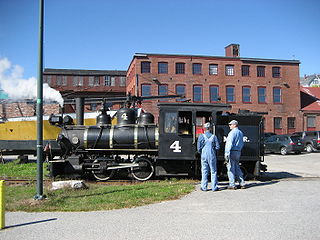
Albion is a town in Kennebec County, Maine, United States. The population was 2,006 at the 2020 census.

The Maine Central Railroad was a U. S. class 1 railroad in central and southern Maine. It was chartered in 1856 and began operations in 1862. By 1884, Maine Central was the longest railroad in New England. Maine Central had expanded to 1,358 miles (2,185 km) when the United States Railroad Administration assumed control in 1917. The main line extended from South Portland, Maine, east to the Canada–United States border with New Brunswick, and a Mountain Division extended west from Portland to St. Johnsbury, Vermont, and north into Quebec. The main line was double track from South Portland to Royal Junction, where it split into a "lower road" through Brunswick and Augusta and a "back road" through Lewiston, which converged at Waterville into single track to Bangor and points east. Branch lines served the industrial center of Rumford, a resort hotel on Moosehead Lake and coastal communities from Bath to Eastport.

The Sandy River and Rangeley Lakes Railroad (SR&RL) was a 2 ft narrow gauge common carrier railroad that operated approximately 112 miles (180 km) of track in Franklin County, Maine. The former equipment from the SR&RL continues to operate in the present day on a revived, short segment of the railway in Phillips, Maine.

The Wiscasset, Waterville and Farmington Railway is a 2 ft narrow gauge railway. The line was operated as a for-profit company from 1895 until 1933 between the Maine towns of Wiscasset, Albion, and Winslow, but was abandoned in 1936. Today 3.5 miles (5.6 km) of the track in the town of Alna has been rebuilt and is operated by the non-profit Wiscasset, Waterville and Farmington Railway Museum as a heritage railroad offering passenger excursion trains and hauling occasional cargo.

The Bridgton and Saco River Railroad (B&SR) was a 2 ft narrow gauge railroad that operated in the vicinity of Bridgton and Harrison, Maine. It connected with the Portland and Ogdensburg Railroad from Portland, Maine, to St. Johnsbury, Vermont, near the town of Hiram on the Saco River.

The Monson Railroad was a 2 ft narrow gauge railway, which operated between Monson Junction on the Bangor and Aroostook Railroad and Monson, Maine. The primary purpose of this railroad was to serve several slate mines and finishing houses in Monson. According to the Scientific American of 17 May 1890, it was the smallest railroad in the United States.
The Kennebec Central Railroad was a 2 ft narrow gauge railroad operating between Randolph and Togus, Maine. The railroad was built to offer transportation for American Civil War veterans living at Togus to the nearby City of Gardiner. Tracks of 25-pound steel rails ran five miles from Randolph, Maine to the veterans home at Togus. Train service began on 23 July 1890.
The Sandy River Railroad was a 2 ft narrow gauge railway built to serve the towns of Strong and Phillips in the Sandy River valley upstream of Farmington. The Sandy River Railroad was the first narrow gauge common carrier railroad built in the State of Maine.

The Franklin and Megantic Railway (F&M) was a 2 ft narrow gauge railway in northern Maine that branches off from the Sandy River Railroad (SRR) at Strong and served sawmills in Salem township and in the town of Kingfield.
The Phillips and Rangeley Railroad was a 2 ft narrow gauge common carrier railroad in the State of Maine.

The Maine Narrow Gauge Railroad Co. & Museum is a 2 ft narrow gauge railway, located in Portland, Maine, United States.

The Rockland Branch is a railroad from Brunswick, Maine to Rockland, Maine. A charter was granted in 1849 to build a railway from the Portland and Kennebec Railroad on the west side of the Kennebec River to Rockland. Construction through the rocky headlands of the Atlantic coast proved more expensive than anticipated. The Knox and Lincoln Railroad commenced service to Rockland in 1871 using a ferry to cross the Kennebec River between Bath and Woolwich. The Knox and Lincoln was leased by Maine Central Railroad in 1891, and became Maine Central's Rockland Branch in 1901. Maine Central purchased the Samoset destination hotel in nearby Glen Cove in 1912, and offered direct passenger service for summer visitors from the large eastern cities. Carlton bridge was completed in 1927 to carry the railroad and U.S. Route 1 over the Kennebec River. Maine Central sold the Samoset hotel in 1941, and the last Maine Central passenger train to Rockland was on 4 April 1959. The State of Maine purchased the branch in 1987 to prevent abandonment. The line has subsequently been operated by the Maine Coast Railroad, the Maine Eastern Railroad, and, beginning in 2016, the Central Maine and Quebec Railway. In 2019, Canadian Pacific Railway agreed to purchase the Central Maine and Quebec, thereby inheriting the operation of the Rockland Branch. The acquisition was completed on June 3, 2020.

5 ft 6 in (1,676 mm) is a broad track gauge, used in India, Pakistan, western Bangladesh, Sri Lanka, Argentina, Chile, and on BART in the San Francisco Bay Area.

Originally, various track gauges were used in the United States. Some railways, primarily in the northeast, used standard gauge of 4 ft 8+1⁄2 in ; others used gauges ranging from 2 ft to 6 ft. As a general rule, southern railroads were built to one or another broad gauge, mostly 5 ft, while northern railroads that were not standard-gauge tended to be narrow-gauge. The Pacific Railroad Acts of 1863 specified standard gauge.
The following is a timeline of the history of the city of Portland, Maine, USA.
The Sebasticook and Moosehead Railroad was a 19th-century Maine railroad which became the 20th century Harmony Branch of the Maine Central Railroad.

The Maine Central Railroad Company main line extended from Portland, Maine, east to the Canada–US border with New Brunswick at the Saint Croix–Vanceboro Railway Bridge. It is the transportation artery linking Maine cities to the national railway network. Sections of the main line had been built by predecessor railroads consolidated as the Maine Central in 1862 and extended to the Canada–US border in 1882. Through the early 20th century, the main line was double track from South Portland to Royal Junction, where it split into a lower road through Brunswick and Augusta and a back road through Lewiston which converged at Waterville into single track to Bangor and points east. Westbound trains typically used the lower road with lighter grades, while eastbound trains of empty cars used the back road. This historical description does not include changes following purchase of the Maine Central Railroad by Guilford Transportation Industries in 1981 and subsequent operation as part of Pan Am Railways.

Wiscasset is a town in and the seat of Lincoln County, Maine, United States. The municipality is located in the state of Maine's Mid Coast region. The population was 3,742 as of the 2020 census. Home to the Chewonki Foundation, Wiscasset is a tourist destination noted for early architecture and as the location of Red's Eats restaurant.















